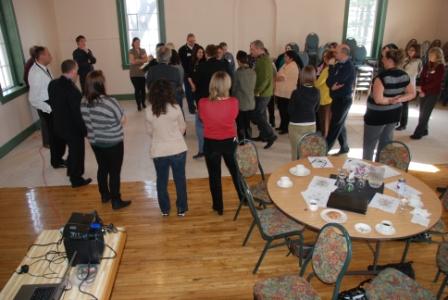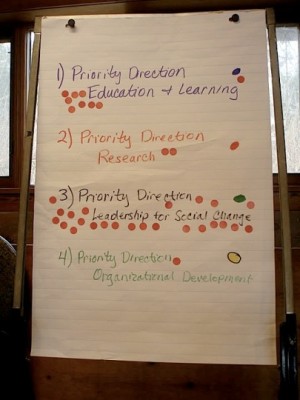7 Things We Learned from Alan Quarry about Social Media for Social Change
At a recent event to launch the Friends of Crime Prevention network, we were so fortunate to have Alan Quarry, of Quarry Communications, as our guest. Since we’re all about positive social change, we asked Alan to wax poetic on the power of networks, like Friends of Crime Prevention, to advance social change. Anyone looking for tips on the latest tools, apps and gadgets to use might have been disappointed by Alan’s talk… because really, it’s all about relationships, not the technology, which we already knew. Right?
Creating change that lasts happens in relationships, from one person to another, and these days, often facilitated with the power of social media. Here are Alan’s 7 best thoughts on the principles for engaging people in change.
- “We build too many walls and not enough bridges”. Isaac Newton
Plain and simple…. Walls separate people; Bridges bring people together. Networks can only be successful if they are built on the principles of a good bridge:
– bridges are intended to facilitate two-way interaction and communication, comings-and-goings and flow of pedestrians and traffic; they connect physical spaces to each other across seemingly uncrossable barriers like water, chasms and gorges
– bridges are (typically) not controlled by one side or the other
– bridges do not have trolls! or at least, they shouldn’t!
– bridges are intended to be multipurpose and can accomplish a great diversity all at once
– bridges need care and maintenance in order to last for a long time
– bridges inspire people and we are naturally drawn to them to admire; while many bridges are utilitarian in nature, many more are grand and quite beautiful to look at
– bridges can often connect very different worlds and be an entrance into exploring a very new and different place
– bridges can act as ‘neutral territory’, which can be a very good thing at time!
Having said all that…. bridges can be uncomfortable places for people with a fear of high places. It can take work for some people to engage in these spaces – be patient with them! But if there is a compelling reason for them to be there… they will. - Networking is not about hunting. It is about farming. It’s about cultivating relationships.
Networking is a key component of building any network, not just Friends of Crime Prevention. But how to engage people who are interested in sticking with the network for the long haul? It’s about building genuine relationships with everyday people. It’s not about head-hunting big names or seemingly important people. Some relationships take longer to develop than others, but guaranteed, an investment in a solid relationship with someone will build stronger connections and commitment to your network. - Build it, and they won’t come
 Enough said. You can build a bridge, or a network…. but that doesn’t mean everyone will want to take part or use it… especially if it’s poorly designed and built! It’s important to put careful thought, planning and resources into whatever you design. And opportunities to improve it are always there!!
Enough said. You can build a bridge, or a network…. but that doesn’t mean everyone will want to take part or use it… especially if it’s poorly designed and built! It’s important to put careful thought, planning and resources into whatever you design. And opportunities to improve it are always there!! - Focus on how to ‘be’ social not how to ‘do’ social
Many attempt to engage people can ring false when there is a lack of authenticity in the engagement. You can ‘do’ all the right things when it comes to social and community engagement but if your online & in-real-life personality don’t match – people can become quickly disengaged. Sharing good content – relevant, personal and recent – with the right people, at the right time, shows you understand the important of connecting in the right way. - You have to make an effort to connect with people. It’s not called ‘net’sitting. Work at it.
Yes. And yes. It’s not enough to have online profiles everywhere and attend every community event possible if you don’t actually engage with people. Just because there’s a Facebook page and a Twitter account doesn’t mean people will flock to you in droves. Work at making connections that make sense. Avoid the flailing arm approach to engagement. - Social media is high touch, not high tech

Like the construction of this bridge, there is some technical thought that goes in to building a network like the Friends of Crime Prevention, and effectively using social media to help it grow. The real success of the bridge in the photo is whether or not people come to gather there when the vendors fill the shops on the sides of the bridge – the high touch part of the equation. We can’t expect technology alone to sustain relationships. We’ve got to do that part in person. - “Be positive – care, share and be friendly”
According to Alan, this statement is also the Quarry Family motto. But it sure applies to something like advancing the ‘Friends of Crime Prevention’ network. Really, who flocks to be part of something negative, territorial, selfish and unfriendly? I just don’t think it would work for something called ‘Friends of Crime Prevention’!
Truly, Alan’s presentation for the Friends of Crime Prevention event got people talking and primed to help grow the network. People talked about actions they could take as individuals and organizations to help advance the work of crime prevention through social development in their own workplaces, homes, schools, families and neighbourhoods. Ideas are percolating. Discussions are happening. Links are circulating. Tweets are tweeting. Phones are ringing. In all, I’d say, a pretty good ROI for the day.
Return on Interaction, that is.
Thanks Alan Quarry!
What were the stand out ideas you learned from Alan at this event? Is Friends of Crime Prevention on the right track? Love to hear your thoughts – leave a comment!




